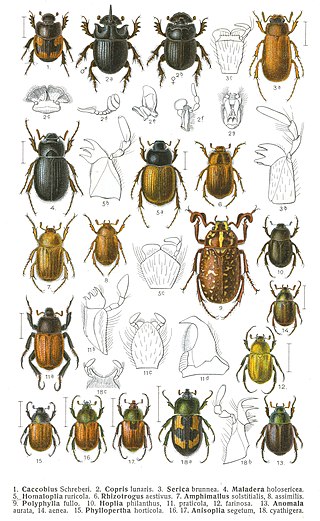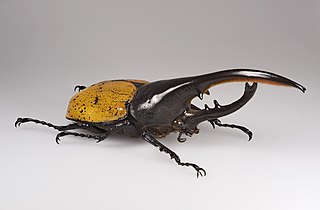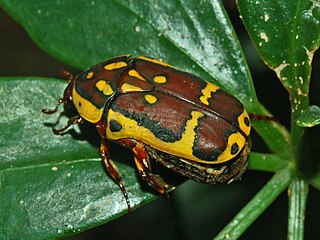
The family Scarabaeidae, as currently defined, consists of over 30,000 species of beetles worldwide; they are often called scarabs or scarab beetles. The classification of this family has undergone significant change in recent years. Several subfamilies have been elevated to family rank, and some reduced to lower ranks. The subfamilies listed in this article are in accordance with those in Bouchard (2011).

The Edwards Plateau is a geographic region forming the crossroads of Central, South, and West Texas. It is bounded by the Balcones Fault to the south and east, the Llano Uplift and the Llano Estacado to the north, and the Pecos River and Chihuahuan Desert to the west. San Angelo, Austin, San Antonio, and Del Rio roughly outline the area. The southeast portion of the plateau is known as the Texas Hill Country.

The Hercules beetle is a species of rhinoceros beetle native to the rainforests of Central America, South America, and the Lesser Antilles. It is the longest extant species of beetle in the world, and is also one of the largest flying insects in the world.

Dynastinae or rhinoceros beetles are a subfamily of the scarab beetle family (Scarabaeidae). Other common names – some for particular groups of rhinoceros beetles – include Hercules beetles, unicorn beetles or horn beetles. Over 1500 species and 225 genera of rhinoceros beetles are known.

Allomyrina dichotoma, also known as Japanese rhinoceros beetle, Japanese horned beetle, or kabutomushi, is a species of rhinoceros beetle.

Macrodontia cervicornis, also known as the sabertooth longhorn beetle, is one of the largest beetles, if one allows for the enormous mandibles of the males, from which it derives both of the names in its binomen: Macrodontia means "long tooth", and cervicornis means "deer antler". Measurements of insect length normally exclude legs, jaws, or horns, but if jaws are included, the longest known specimen of M. cervicornis is 17.7 cm; the longest known specimen of Dynastes hercules, a beetle species with enormous horns, is 17.5 cm, and the longest known beetle excluding either jaws or horns is Titanus giganteus, at 16.7 cm.

Paracotalpa granicollis is a beetle of the family Scarabaeidae. The species is found in the Intermountain West of North America, including the Columbia Plateau, Great Basin, and Colorado Plateau.

Xylotrupes gideon, the brown rhinoceros beetle, is a species of large scarab beetle belonging to the subfamily Dynastinae.
Mascaromyia is a genus of flies in the family Dolichopodidae, endemic to the western Indian Ocean islands. It is named after the main distribution of the genus, the islands of the submarine Mascarene Plateau, combining it with "myia".

Chelodina (Chelydera) burrungandjii, the sandstone snake-necked turtle or Arnhem Land long-necked turtle, is a medium-sized turtle reaching carapace lengths of 316 mm. The species is found in the sandstone plateaus and escarpments and the plunge pools of Arnhem Land of the Northern Territory. The species had been long recognised as valid. However, it had been difficult to research due to the remoteness of its habitat. Efforts to breed this species in captivity had been largely unsuccessful, until National Aquarium Herpetologist Matthew Benedict lead a successful breeding project in 2021. The species occurs in proximity to Chelodina rugosa, to which it is closely related. For the most part the two species are parapatric in distribution. However, they do come together in limited locations such as plunge pools at the base of the escarpments. In these areas there is hybridization between the species.

Mimela junii is a species of shining leaf chafer belonging to the family Scarabaeidae subfamily Rutelinae.

Pachnoda fissipunctum is an African scarab beetle in the subfamily Cetoniinae. It was originally described in 1885 as a variety of Pachnoda flavicollis.

Anoplognathus brunnipennis, commonly known as the brown- or golden-brown Christmas beetle, is a beetle of the family Scarabaeidae native to eastern Australia, being common in coastal Queensland, New South Wales and Victoria, the Great Dividing Range and the Murray-Darling river basin.

Mimela is a genus of shining leaf chafer belonging to the family Scarabaeidae subfamily Rutelinae.

Cartwrightia is a genus of scarab found in Latin America. It was named and circumscribed in 1958 by Federico Islas Salas. As of 2017, three species are recognized: C. intertribalis, C. cartwrighti, and C. islasi. They can be found in the nests of leafcutter ants or in dung.

Anomalini is a tribe of shining leaf chafers in the family Scarabaeidae. There are about 1300 described species in Anomalini worldwide, including 60 in North America.
Mimela macleayana, is a species of true dung beetle found in India and Sri Lanka.

Gymnopleurus sericeifrons, is a species of dung beetle found in Afro-tropical countries such as Mozambique, Kenya, India and Sri Lanka.

Onitis subopacus is a species of dung beetle found in Austro-Oriental, Oriental, South and West Palearctic regions.

Ceafornotensis is an extinct terrestrial genus of beetles in the superfamily Scaraboidea, with only one member, Ceafornotensis archratiras. It is currently extinct globally. Its name is based on the Old English word ceafor( chafer) and Greek word notius (south).
















